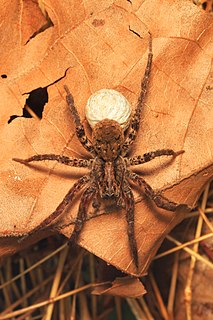
Myrmecia is a genus of ants first established by Danish zoologist Johan Christian Fabricius in 1804. The genus is a member of the subfamily Myrmeciinae of the family Formicidae. Myrmecia is a large genus of ants, comprising at least 93 species that are found throughout Australia and its coastal islands, while a single species is only known from New Caledonia. One species has been introduced out of its natural distribution and was found in New Zealand in 1940, but the ant was last seen in 1981. These ants are commonly known as "bull ants", "bulldog ants" or "jack jumper" ants, and are also associated with many other common names. They are characterized by their extreme aggressiveness, ferocity, and painful stings. Some species are known for the jumping behavior they exhibit when agitated.

Gladicosa gulosa is a type of wolf spider found in Beech-Maple forests of the US and Canada, where the spider can be found in the plant strata of ground, herb or shrub. It is not one of the more common wolf spiders.

The red bull ant, also known as the giant bull ant or "hoppy joe", is a species of bulldog ant from the genus Myrmecia. It is abundant throughout Eastern Australia.

Thelaziasis is the term for infestation with parasitic nematodes of the genus Thelazia. The adults of all Thelazia species discovered so far inhabit the eyes and associated tissues of various mammal and bird hosts, including humans. Thelazia nematodes are often referred to as "eyeworms".

Spiders are air-breathing arthropods that have eight legs, chelicerae with fangs generally able to inject venom, and spinnerets that extrude silk. They are the largest order of arachnids and rank seventh in total species diversity among all orders of organisms. Spiders are found worldwide on every continent except for Antarctica, and have become established in nearly every habitat with the exceptions of air and sea colonization. As of July 2019, at least 48,200 spider species, and 120 families have been recorded by taxonomists. However, there has been dissension within the scientific community as to how all these families should be classified, as evidenced by the over 20 different classifications that have been proposed since 1900.

The citrus peelminer is a moth of the family Gracillariidae. It is known from California, Arizona, Texas and Florida in the United States and from Cuba.
Agyneta gulosa is a species of sheet weaver found in the Palearctic. It was described by L. Koch in 1896.

Gladicosa is a genus of wolf spiders found in the United States and Canada.
Oedignatha affinis is a species of spider of the genus Oedignatha endemic to Sri Lanka.
Oedignatha bicolor is a species of spider of the genus Oedignatha endemic to Sri Lanka.
Oedignatha coriacea is a species of spider of the genus Oedignatha endemic to Sri Lanka.
Oedignatha flavipes is a species of spider of the genus Oedignatha endemic to Sri Lanka.
Oedignatha major is a species of spider of the genus Oedignatha endemic to Sri Lanka.
Oedignatha montigena is a species of spider of the genus Oedignatha endemic to Sri Lanka.
Oedignatha proboscidea is a species of spider of the genus Oedignatha endemic to Sri Lanka.
Oedignatha retusa is a species of spider of the genus Oedignatha endemic to Sri Lanka.
Oedignatha striata is a species of spider of the genus Oedignatha endemic to Sri Lanka.
Oedignatha is a genus of Asian spiders first described by Tamerlan Thorell in 1881 as a genus of corrinid sac spiders, and moved to Liocranidae in 2014.





